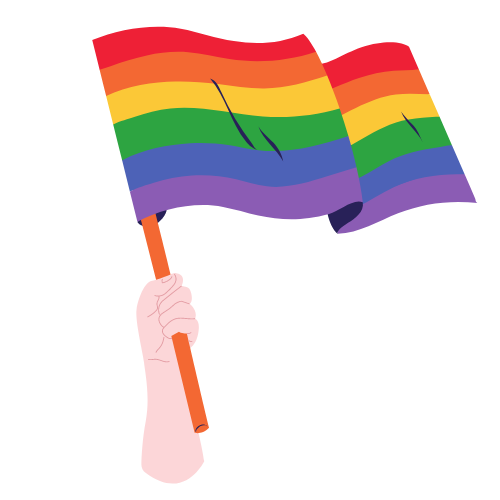People who identify as LGBTQ+
What the evidence shows
The evidence shows that LGBTQ+ people have disproportionately worse health outcomes and experiences of healthcare. Within this population people experience higher rates of a wide range of health issues, including poor mental health, substance use disorders, and chronic illnesses, which can reduce life expectancy and complicate end-of-life care.
Evidence shows that in many instances, the end-of-life care that LGBTQ+ people receive is not inclusive of them, and despite best intentions and a willingness to learn, staff feel they lack the knowledge and training needed. LGBTQ+ individuals continue to face inequalities and disparities due to factors including discrimination, lack of cultural competency among healthcare providers, and limited support structures. These disparities can significantly impact the quality of care and the experiences of LGBTQ+ individuals and their families during the end-of-life period.
Discrimination and stigma continue to be huge barriers that can manifest as either concious or unconcious bias from healthcare staff, resulting in inadequate or inappropriate care. This fear of discrimination may prevent LGBTQ+ individuals from seeking the care they need or disclosing their identities, which can hinder effective treatment and support and impacts the experience of their loved ones.
In some situations, legal issues can impact end-of-life care for LGBTQ+ individuals, affecting decisions about care and decision-making authority. For instance, same-sex partners may encounter obstacles related to visitation rights or decision-making in medical contexts if they are not legally recognised as next of kin. Often, LGBTQ+ individuals rely heavily on a wider support network of friends due to strained relationships with biological family members. This may be problematic where these chosen family structures are not recognised, or assumptions are made about the relationship status, potentially isolating individuals from crucial emotional and practical support networks.
What Kirklees organisations told us
Colleagues in Kirklees highlighted specific issues facing LGBTQ+ people in their experience of end-of-life care, both as a patient, and as a carer. Much of the discussion focussed on current heteronormative approaches within health and care services in general, where gender identity and sexuality are assumed, rather than confirmed.
Heteronormativity is an issue that affects how the LGBTQ+ community access services and our sexuality is assumed heterosexual until declared otherwise. This can cause the "back in the closet" issue whereby older LGBTQ+ people and their partners are assumed to be heterosexual and therefore common-law partners may not be included in the end-of-life planning process... this can be traumatic for both the person who is dying, and for the person who has to cope with the loss of their partner.
Key issues from this discussion include:
Support for partners and loved ones
Assumptions relating to gender identity and sexuality extended beyond the patient to loved ones, including partners and other family members. This was felt to create awkwardness and difficulty in openly supporting loved ones where relationships were incorrectly assumed. There were also concerns raised about how this might impact partners after the death of a loved one, who might not have easy access to the full range of support available.
Often LGBTQ+ partners are like forgotten about after death because they might not have been known in their right capacity, who they were. So that person might not have been asked, they might not have felt safe.
Person-centred approaches
For many people from LGBTQ+ communities, there is apprehension about one day having to access end-of-life care services, in part due to a range of previous negative experiences with other healthcare services. It is important to consider these prior experiences and wider holistic factors that might impact an individual's experience of healthcare across their life, not just towards the end.
Even though that someone has a life limiting illness and they're end-of-life planning...see them as a holistic person, they're not just the illness.
The thing that often occurs to me about LGB and queer populations, is that they're often defined by a medical notion of who they have sex with, and actually, that is one tiny part of any individual's identity, regardless of sexuality, but certainly in terms of how people are experiencing end-of-life. Like any other part of the life course, they will have very individual approaches that goes far beyond any perceived gender of someone that they're attracted to.
Training
Feedback from our discussion groups highlighted a lack of training or awareness of LGBTQ+ health issues, including unique end-of-life concerns regarding family dynamics. Examples were given where this had resulted in misunderstandings, insensitivity, or failure to address specific needs related to sexual orientation, gender identity, or chosen families. For example, transgender individuals may face challenges related to gender-affirming care or respectful use of pronouns which extends beyond the care setting to a fear for how they will continue to be referred to following their death (e.g. use of birth name, rather than chosen name).
I've had nurses have sometimes said, 'oh, I'm really sorry to have to ask you this, but how do you identify?' And I always think why are you apologising for having to ask me that question? What is it about that question that's making you uncomfortable?
Recommendations
Development of training to raise awareness of LGBTQ+ health issues, including unique end-of-life concerns regarding family dynamics and the importance of non-family networks. This should continue to build upon training across the wider health and care system to ensure healthcare professionals are confident and comfortable to discuss gender identity and sexuality with their patients.
